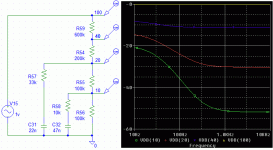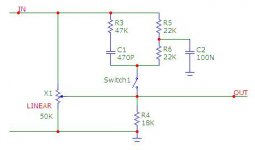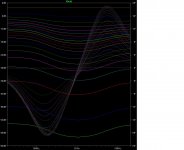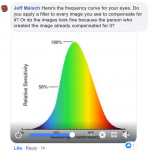Yeah, why ? Aren't us in the sound reproduction section?At rock concerts and festivals
What's the similarity between live and reproduced ?
HAve you heard about room gain?
The only similarity is the distance from the source and its acoustic level, the one you would easily accomodate with the use of the volume control 🙄
You could make a loudness-derived tone control, that is, a tone control of which the curves resemble the differences between the latest equal-loudness contours (ISO 226:2003).
If you have no objections against large inductors, you could try (or simulate) the attached circuit with the 28 H inductor reduced to 20 H and the 1 uF capacitors increased a couple of times. C3 and L2 are for treble and won't be needed.
The picture is the Viddeleer tone control that was rather well-known in the Netherlands in the 1950's, but I don't think anyone outside the Netherlands ever heard of it. I did some calculations on a simplified version of it, with R3 and R4 increased to infinity and the switched resistors resized, and at least that could match ISO 226:2003 rather well.
If you have no objections against large inductors, you could try (or simulate) the attached circuit with the 28 H inductor reduced to 20 H and the 1 uF capacitors increased a couple of times. C3 and L2 are for treble and won't be needed.
The picture is the Viddeleer tone control that was rather well-known in the Netherlands in the 1950's, but I don't think anyone outside the Netherlands ever heard of it. I did some calculations on a simplified version of it, with R3 and R4 increased to infinity and the switched resistors resized, and at least that could match ISO 226:2003 rather well.
Attachments
Was this another creation from Philips in Eindhoven, perhaps? It's incredible how many fantastic advances in audio were created by that one company....Viddeleer tone control...Netherlands in the 1950's
I don't understand the schematic you posted, yet. Feedback from anode to cathode? That should be positive feedback! 😕
-Gnobuddy
No, L. V. Viddeleer worked for the PTT, the former Dutch postal, telephone and telegraph service. I have the impression that high-fidelity audio was a hobby for him. He designed and published a rather unusual, but very well-designed amplifier with this tone control.
The centre of the resistor chain is grounded, so the left part simply provides local series feedback at the cathode, while the right part loads the anode. It looks a bit like the dual of the Baxandall tone control, but not exactly.
The Baxandall tone control essentially has an impedance that converts the input voltage into a current and then an amplifier with shunt feedback that converts the current back into a voltage. The Viddeleer tone control has an amplifier with series feedback that converts the input voltage into a current and then an impedance to convert it back into a voltage. Baxandall uses capacitors, Viddeleer inductors.
The most important difference is that with inductors, the time constants tend to increase rather than decrease when you only want a small correction - although the bias resistors R3 and R4 disturb this to some extent. The cathode resistor R3 could easily be replaced with a current source, though.
The centre of the resistor chain is grounded, so the left part simply provides local series feedback at the cathode, while the right part loads the anode. It looks a bit like the dual of the Baxandall tone control, but not exactly.
The Baxandall tone control essentially has an impedance that converts the input voltage into a current and then an amplifier with shunt feedback that converts the current back into a voltage. The Viddeleer tone control has an amplifier with series feedback that converts the input voltage into a current and then an impedance to convert it back into a voltage. Baxandall uses capacitors, Viddeleer inductors.
The most important difference is that with inductors, the time constants tend to increase rather than decrease when you only want a small correction - although the bias resistors R3 and R4 disturb this to some extent. The cathode resistor R3 could easily be replaced with a current source, though.
Firstly, nobody knew about Fletcher-Munson curves when pianos and orchestras were invented!........
Just to be argumentative: look at the development of keyboards-- Clavichord, Harpsichord, Fortepiano, coming toward the Steinway and friends. The older instruments were soft and had no bass. They didn't need some Curves to know they would like to have MORE, both level and bottom-end.
And there's no Loudness knob because the player is IN the space, and adjusts hand-action to suit. In Hi-Fi the player never saw your room, you have to make the adjustments the player might have made if the act would even fit in your room.
Similar for orchestras. Early ones only ran as deep as 1 or 2 viol de gambas, because that's all you could carry to small-town gigs. In larger venues this gives a "thin" presentation. Later urban high-head-count orchestras grew to ranks of players including a gang of double-basses. Military bands grew tubas and Sousaphones.
This is how Philips did it .... I'm too lazy to work out what at frequencies and volumes it's doing the shaping...
I threw it to the Idiot Assistant and got these shapes.
Slope approaches 7.5dB/octave on the lowest tap near 100Hz-200Hz.
Attachments
I heard a lion indoors three meters away from me. It only roared a little but it was still very loud. Without the bars between us I would **** myself while running and screaming, beeing dead a few seconds later. At the same time I wanted to kick its as, cause I felt so offended.
I did use the loudness control, mostly in a "set and forget way
-Gnobuddy
Yeah I would also set and forget at a level where it was never too much
Has anybody tried this passive loudness circuit? I guess it has been mentioned before in Diyaudio. It uses a linear pot with a log-faking resistor. When the switch is on, lows and highs are boosted up to 0-6db depending on volume setting. Center frequency is around 1kHz.
I use a variation of this circuit in my main amp. Mine is a transistor amp, but component values may easily be adapted to fit for tubes.
It works OK, the sound stage brightens up, but you clearly notice the phase change when you push the button. Up to plus and minus 20deg shift at the lower levels for highs and lows respectively. If you insert a resistor before/after the filter its effect will be reduced.
I use a variation of this circuit in my main amp. Mine is a transistor amp, but component values may easily be adapted to fit for tubes.
It works OK, the sound stage brightens up, but you clearly notice the phase change when you push the button. Up to plus and minus 20deg shift at the lower levels for highs and lows respectively. If you insert a resistor before/after the filter its effect will be reduced.
Attachments
The question is, does it change depending on the intensity of the light?
What if it does? Is not your hearing tuned to compensate this difference already?
The value of F-M work is, Bell Labs selected an optimal bandwidth for phone conversations, to save helluva money!
That's it!
I have no idea who invented the hoax about "F-M Loudness Control", but he was a genius! People still believe, despite can calculate what happened in loudness control of German radios, that had nothing in common with F-M curves, instead used excess power to extend bass on frequencies below Fs boosting up to 12 dB/Oct. It was a great idea, bass boost really, to extend bass output for the expense of output power that was not needed on low loudness! From radios it went to hi-fi receivers, and was alive while speakers did not have wide enough frequency response. With more power available just drivers with heavier cones were used that had lower Fs for expense of efficiency, so Loudness Control slowly died with such speakers.
What if it does? Is not your hearing tuned to compensate this difference already?
Obviously not, as music played on a low volume clearly sounds thinner than at high volume.
As an aside, there are far more up to date equal loudness curves than those of 1933.
Obviously not, as music played on a low volume clearly sounds thinner than at high volume.
As an aside, there are far more up to date equal loudness curves than those of 1933.
Good luck then!


My system does not sound flat, because it has flat frequency response on any loudness in the room, carefully designed and EQed. If yours has lack of bass, on high loudness it may sound as if has enough of bass, that's it.
Last edited:
There is a huge person-to-person spread, maybe your equal loudness contours vary less with level than mine. That huge person-to-person spread is one of the many reasons why a fixed loudness control (compensation only dependent on the volume control and nothing else) can never work well.
Sure. Some people use measurement tools to understand what is wrong, other people try to fix their tools so they do not show that. 😀
Your hearing in this particular case is a tool that tells you that you have lack of bass, that's why on low loudness it sounds thin. Mine has flat frequency response, so nobody complains on lack of bass on any loudness, neither on excess of it.
Have you ever seen "F-M-Compensated" studio monitors? Or headphones? Why?
Think.
Your hearing in this particular case is a tool that tells you that you have lack of bass, that's why on low loudness it sounds thin. Mine has flat frequency response, so nobody complains on lack of bass on any loudness, neither on excess of it.
Have you ever seen "F-M-Compensated" studio monitors? Or headphones? Why?
Think.
I am lucky. My apartment has excellent acoustics, and my speakers are quite well behaved (RC-70).
I have no EQ active in the system, but it sounds great with any genre I like and at any volume. My first tube stereo was from a console from Yugoslavia, and instead of "volume" it had "loudness", and all the knobs were wired backwards to today (you turned up the loudness by turning the control CCW). Handy for the rubbish speakers it came built with, but annoying when you're trying to get a flat response from the amp.
I have no EQ active in the system, but it sounds great with any genre I like and at any volume. My first tube stereo was from a console from Yugoslavia, and instead of "volume" it had "loudness", and all the knobs were wired backwards to today (you turned up the loudness by turning the control CCW). Handy for the rubbish speakers it came built with, but annoying when you're trying to get a flat response from the amp.
A great post today on Facebook. 😀
That is related to eyesight - Not hearing.
Cheers!
And an amazing amount of chemical, physical and electrical compensation is needed just for me to see what im writing on this forum. Cheers!
Have you ever seen "F-M-Compensated" studio monitors? Or headphones? Why? Think.
What you compensate for, is the difference between the equal loudness contours at the actual level and the level at which the recording was made or was mastered. How the hell could a headphone know what that difference is in the first place?
- Home
- Amplifiers
- Tubes / Valves
- Loudness controls




